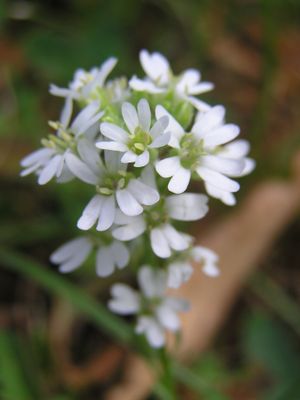Gray cress
| Gray cress | ||||||||||||
|---|---|---|---|---|---|---|---|---|---|---|---|---|

Gray cress inflorescence ( Berteroa incana ) |
||||||||||||
| Systematics | ||||||||||||
|
||||||||||||
| Scientific name | ||||||||||||
| Berteroa | ||||||||||||
| DC. |

The plant genus gray cress ( Berteroa ) belongs to the cruciferous family (Brassicaceae). Characteristic are the mostly pure white, rarely yellow petals , which are nailed, inverted-heart-shaped and deeply two-parted at the top. Berteroa are named after the Italian doctor, botanist and plant collector Carlo Giuseppe Luigi Bertero (1789–1831).
description
Vegetative characteristics
In Berteroa TYPES comes to annual to perennial herbaceous plants . Simple and star hairs ( trichomes ) are found on many parts of the plant . The ascending to erect stems are simple or branched. The alternate leaves arranged on the stem are divided into a petiole and a leaf blade. The simple leaf blade has a smooth, wavy or toothed leaf edge.
Generative characteristics
Some flowers stand close together in racemose inflorescences. There are no bracts. The hermaphroditic flowers are fourfold with double perianth . The four fluffy hairy sepals are elongated, almost erect or spread out. Characteristic are the mostly pure white, rarely yellow petals , which are nailed, inverted-heart-shaped and deeply two-parted at the top. There are six stamens . The stamens of the middle pair have no appendages or are monodentate and the side pair has basal, tooth-like appendages. There are four nectar glands. The approximately 4 mm long stylus is smooth or sparsely hairy and ends in a cephalic to barely recognizable bilobed stigma. The ovary contains 4 to 16 ovules .
The thin fruit stalks are erect or ascending. The pods, which are differently shaped depending on the species, can have star hair. The fully formed septum is membranous. The seeds are arranged in two rows in the fruit. The almost circular to kidney-shaped seeds with a tiny net-like seed surface can have a wing or wing-like edge.
The basic chromosome number is x = 8.
distribution
The genus Berteroa has its center of diversity on the Balkan Peninsula . One species ( Berteroa incana ) is common in large parts of Eurasia and is neophyte in North America .
Systematics
The genus Berteroa belongs to the tribe Alysseae in the family Brassicaceae . The generic name Berteroa was first published in 1821 by Augustin Pyrame de Candolle in Mémoires du Muséum d'Histoire Naturelle , 7 (1), p. 232. The botanical genus name Berteroa honors the Italian botanist and plant collector Carlo Giuseppe Luigi Bertero (1789–1831), who emigrated to Chile.
The genus Berteroa contains only five species:
- Berteroa gintlii Rohlena ; is endemic to the western Balkan peninsula
- Gray cress ( Berteroa incana (L.) DC. )
- Berteroa mutabilis (Vent.) DC. ; has the main focus of its distribution on the Balkan Peninsula
- Berteroa obliqua (Sm.) DC. , occurs in Italy, the Balkans, Bulgaria and Turkey
- Berteroa orbiculata DC. ; occurs on the Balkan Peninsula and in Asia Minor.
swell
- Tai-yien Cheo, Lianli Lu, Guang Yang, Ihsan Al-Shehbaz & Vladimir Dorofeev: Brassicaceae . In: Wu Zheng-yi, Peter H. Raven (Ed.): Flora of China . Volume 8: Brassicaceae through Saxifragaceae . Science Press / Missouri Botanical Garden Press, Beijing / St. Louis 2001, ISBN 0-915279-93-2 , pp. 65 (English). Berteroa - Online. (Section description)
- Ihsan A. Al-Shehbaz: Berteroa . In Flora of North America Editorial Committee (Ed.): Flora of North America North of Mexico . Volume 7: Magnoliophyta: Salicaceae to Brassicaceae . Oxford University Press, New York / Oxford a. a. 2010, ISBN 978-0-19-531822-7 , pp. 252 (English, limited preview in Google Book search). (on-line). (Section description, distribution and systematics)
- Jaakko Jalas, Juha Suominen: Atlas florae europaeae . Volume 11 Cruciferae (Ricotia to Raphanus). Pages 62-65, Helsinki 1996. ISBN 951-9108-11-4
Individual evidence
- ^ Berteroa in the Germplasm Resources Information Network (GRIN), USDA , ARS , National Genetic Resources Program. National Germplasm Resources Laboratory, Beltsville, Maryland.
- ↑ Werner Greuter, Hervé-Maurice Burdet, Guy Long (eds.): Med-Checklist. A critical inventory of vascular plants of the circum-Mediterranean countries . Vol. 3: Dicotyledones (Convolvulaceae - Labiatae) . Conservatoire et Jardin Botanique, Genève 1986, ISBN 2-8277-0153-7 . (online) .
